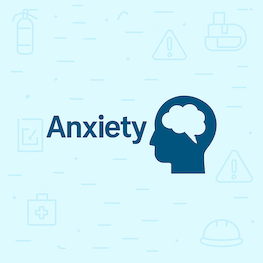Mental Health - What is anxiety?
Anxiety can be defined as a prolonged symptom of stress, which can affect the quality of a persons life.
We all experience anxiety from time to time, especially when facing a situation that makes us feel tense, uncertain or fearful. This could be the thought of sitting an exam, a life changing event, going into hospital, attending a job interview or doing a parachute jump! These worries often affect our sleep, appetite and ability to concentrate.
What are the symptoms of anxiety?
There are many symptoms of anxiety and they vary from person to person. Here are some of the common symptoms.
The feeling of nervousness, tension or restlessness.
An increase in heart rate.
Palpitations.
Sweating.
Feeling tired or weak.
Hyperventilation or breathing rapidly.
Trouble concentrating on things.
Trembling.
Having difficulty controlling worries.
Sleep issues.
Trying to use avoidance tactics to prevent triggering anxiety.
The fight or flight response.
In the short term, anxiety can be really useful as it triggers the release of hormones such as adrenaline and cortisol. These hormones can make us feel more alert and improve our performance. Anxiety can be very important to our survival as it provides a mechanism necessary for protecting us against threat. When we feel under threat, adrenaline is released into the body causing the heart to beat faster; Blood is diverted away from unnecessary tasks like digestion, and over to where it is most needed to ensure that the body is prepared, ready to fight the threat or run away. This is commonly known as the fight or flight response.
According to The Royal College of Psychiatrists, anxiety disorders affect about one in ten people. When a person feels anxious, they experience physical feelings and worrying thoughts. This can make it hard for them to complete even simple tasks and so they begin to avoid things. Quite often, the person does not understand why they feel as they do.
If anxiety levels stay high for a long time period of time, the person may find it difficult to deal with everyday life. The anxiety may become so severe that they feel powerless and out of control.
It is important to remember that the human bodies anxiety response is a normal and healthy reaction to stressful situations. It is the bodies way of readying itself for a challenge, so it is not possible to completely stop this natural response from happening. However, the brain cannot make a distinction between real or perceived threats. Sometimes, the things people feel anxious about might only exist in their own minds, and not actually pose a real physical threat. Talking therapy, like Cognitive Behavioural Therapy (CTB) can help an individual understand if their thinking is helpful or not.
Self help.
Now that we understand a little about anxiety, what are some of the things people can do to help themselves?
Identify the triggers. If a person can understand what causes their anxiety, they can work on ways to manage how they feel. For example, where someone feels anxious about meeting new people, they could work on setting small but achievable goals to help them face potential fears.
Exercise - By undertaking physical exercise, this can help with the physical symptoms of anxiety by using up the excess chemicals produced by the bodies fight or flight response. Exercise also releases endorphins that can help the person feel more positive.
Meditation - You don’t need to be a Buddhist monk to meditate. Simply concentrating on your breathing for just a few minutes can help reduce anxiety and improve concentration.
Avoid alcohol and caffeine - These can make anxiety symptoms worse. Some people try to use alcohol or caffeine in order to ‘help’ them cope. Unfortunately, after the initial feeling passes, the person will feel even more afraid or anxious.
Engage in enjoyable activities - Activities such as listening to music, reading a book, going for a walk or watching a funny movie.
For information of where people can get help, please see our dedicated
signposting page.



